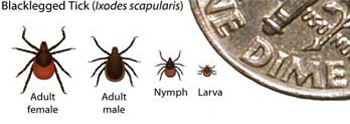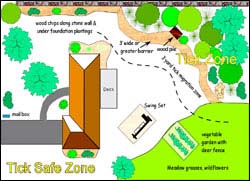It's Spring – Time to Prevent Lyme Disease
 When you're outside this spring and summer, prevent tick bites and reduce your risk of Lyme disease and other tick-borne diseases by following these tips.
When you're outside this spring and summer, prevent tick bites and reduce your risk of Lyme disease and other tick-borne diseases by following these tips.
More cases of Lyme disease are reported than any other vector-borne disease in the United States. There were 29,959 confirmed cases and 8509 probable cases of Lyme disease in the United States in 2009; most of these cases are reported from the Northeast and upper Midwest. See more on Lyme disease statistics.
Lyme disease is caused by the bacterium Borrelia burgdorferi. People become infected with the Lyme disease bacteria when they are bitten by an infected blacklegged tick.
As we start spending more time outdoors during spring and into summer, we have to be aware of the risk of tick bites. Gardening, camping, hiking, and just playing outdoors are all great spring and summertime activities, but make tick protection part of your outdoor plans as well.
Immature ticks (larvae and nymphs) are so small that they can be difficult to see. However, all stages of ticks need to feed on blood to continue on to the next stages—therefore these tiny ticks can be an important threat.
Ticks also feed on mammals and birds, which play a role in maintaining ticks and maintaining the Lyme disease bacteria. Ticks (including species other than the blacklegged ticks) can also transmit diseases other than Lyme disease, including Rocky Mountain spotted fever, erlichiosis, anaplasmosis, Colorado tick fever, and Powassan encephalitis.
Fortunately there are several tactics you and your family can use to prevent tick bites and reduce your risk of tick-borne disease.
Protect Yourself from Tick Bites
Know where to expect ticks. Blacklegged ticks live in moist and humid environments, particularly in or near wooded or grassy areas. You may come into contact with ticks during outdoor activities around your home or when walking through vegetation such as leaf litter or shrubs. To avoid ticks, walk in the center of trails.
Use a repellent with DEET (on skin or clothing) or permethrin (on clothing and gear). Products containing permethrin can be used to treat boots, clothing and camping gear which can remain protective through several washings. Repellents containing 20% or more DEET (N, N-diethyl-m-toluamide) can be applied to the skin, and they can protect up to several hours. Always follow product instructions! Parents should apply repellents to their children, taking care to avoid application to hands, eyes, and mouth.
- For detailed information about using DEET on children, see West Nile Virus: What You Need to Know about Mosquito Repellent.
- For detailed information about tick prevention and control, see Lyme Disease Prevention and Control.
- For detailed information geared to outdoor workers, see NIOSH Safety and Health Topic: Tick-borne Diseases.
Perform Daily Tick Checks
Check your body for ticks after being outdoors, even in your own yard. Conduct a body check upon return from potentially tick-infested areas by searching your entire body for ticks. Use a hand-held or full-length mirror to view all parts of your body and remove any tick you find. Take special care to check these parts of your body and your child's body for ticks:
 Under the arms
Under the arms- In and around the ears
- Inside belly button
- Back of the knees
- In and around all head and body hair
- Between the legs
- Around the waist
Check your clothing and pets for ticks. Ticks may be carried into the house on clothing and pets. Both should be examined carefully, and any ticks that are found should be removed. Placing clothes into a dryer on high heat effectively kills ticks.
What to Do If You Are Bitten by a Tick
Remove an attached tick using fine-tipped tweezers as soon as you notice it. If a tick is attached to your skin for less than 24 hours, your chance of getting Lyme disease is extremely small. But to be safe, watch for signs or symptoms of Lyme disease such as rash or fever, and see a healthcare provider if these develop. For more information, see tick removal.
Your risk of acquiring a tick-borne illness depends on many factors, including where you live, what type of tick bit you, and how long the tick was attached. If you become ill after a tick bite, see a healthcare provider.
You can create tick-safe zones in your yard
- Modify your landscaping to create "Tick-Safe Zones." It's pretty simple. Keep patios, play areas and playground equipment away from shrubs, bushes, and other vegetation. Regularly remove leaf litter and clear tall grasses and brush around your home, and place wood chips or gravel between lawns and wooded areas to keep ticks away from recreational areas (and away from you).
- Use a chemical control agent. Effective tick control chemicals are available for use by the homeowner, or they can be applied by a professional pest control expert. Even limited applications can greatly reduce the number of ticks–a single springtime application of acaricide can reduce the population of ticks that cause Lyme disease by 68–100%.
- Discourage deer. Deer are the main food source for adult ticks. Keep deer away from your home by removing plants that attract deer and constructing physical barriers that may help discourage deer from entering your yard and bringing ticks with them. Deer management has also been studied with regard to its impact on tick populations.
Prevent Ticks on Animals
Prevent family pets from bringing ticks into the home. Maintain your family pet under a veterinarian's care. Two of the ways to get rid of ticks on dogs and cats are putting on tick medicine or using a tick collar. Be sure to use these products according to the package instructions.
Get email updates
To receive email updates about this page, enter your email address:
Contact Us:
- Centers for Disease Control and Prevention
1600 Clifton Rd
Atlanta, GA 30333 - 800-CDC-INFO
(800-232-4636)
TTY: (888) 232-6348 - Contact CDC-INFO





